Conservation Biology Report: Marxian Analysis of Tasmanian Zones
VerifiedAdded on 2021/09/22
|16
|4506
|101
Report
AI Summary
This report delves into the application of Marxian technology to identify and evaluate optimal protection zones for the conservation of endemic flora and fauna in Tasmania. The study utilizes parameters like BML, SPF, and species affectability to determine the most suitable areas for protection. Three scenarios are explored to find the best balance between species richness and cost-effectiveness, aiming to establish bio-economic zones. The introduction highlights the impact of industrial expansion on biodiversity and the importance of conservation efforts through environmental laws and protected areas. The methodology involves a detailed study of Tasmania's biological richness, considering 75 species and employing Marxian programming techniques to analyze geographic and biodiversity data. Results from three scenarios, including clumped reserve designs, are presented, focusing on the identification of potential reserve areas based on BLM attributes and other factors. The report emphasizes the need for awareness and proactive measures to protect wildlife and ecosystems for a sustainable future.
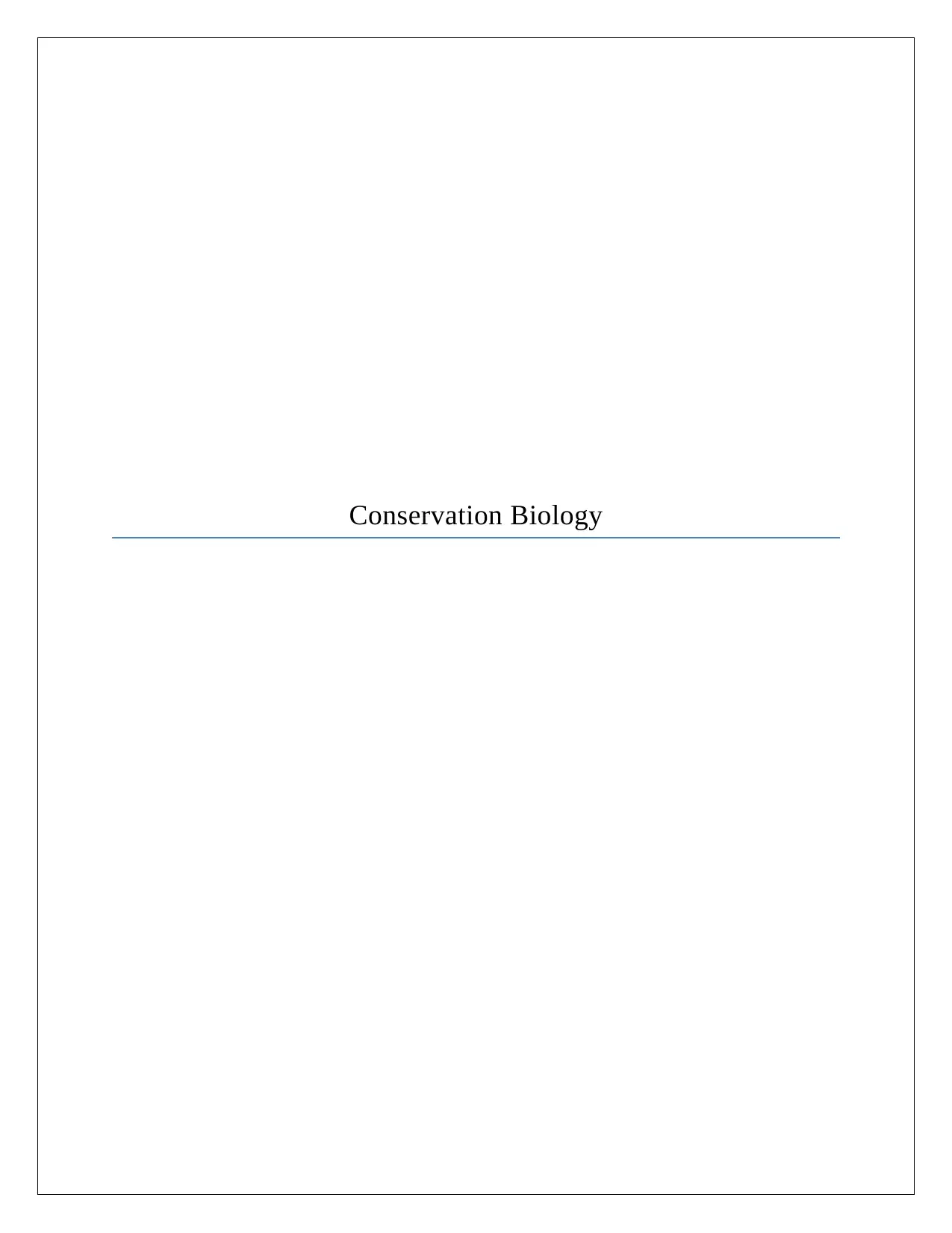
Conservation Biology
Paraphrase This Document
Need a fresh take? Get an instant paraphrase of this document with our AI Paraphraser
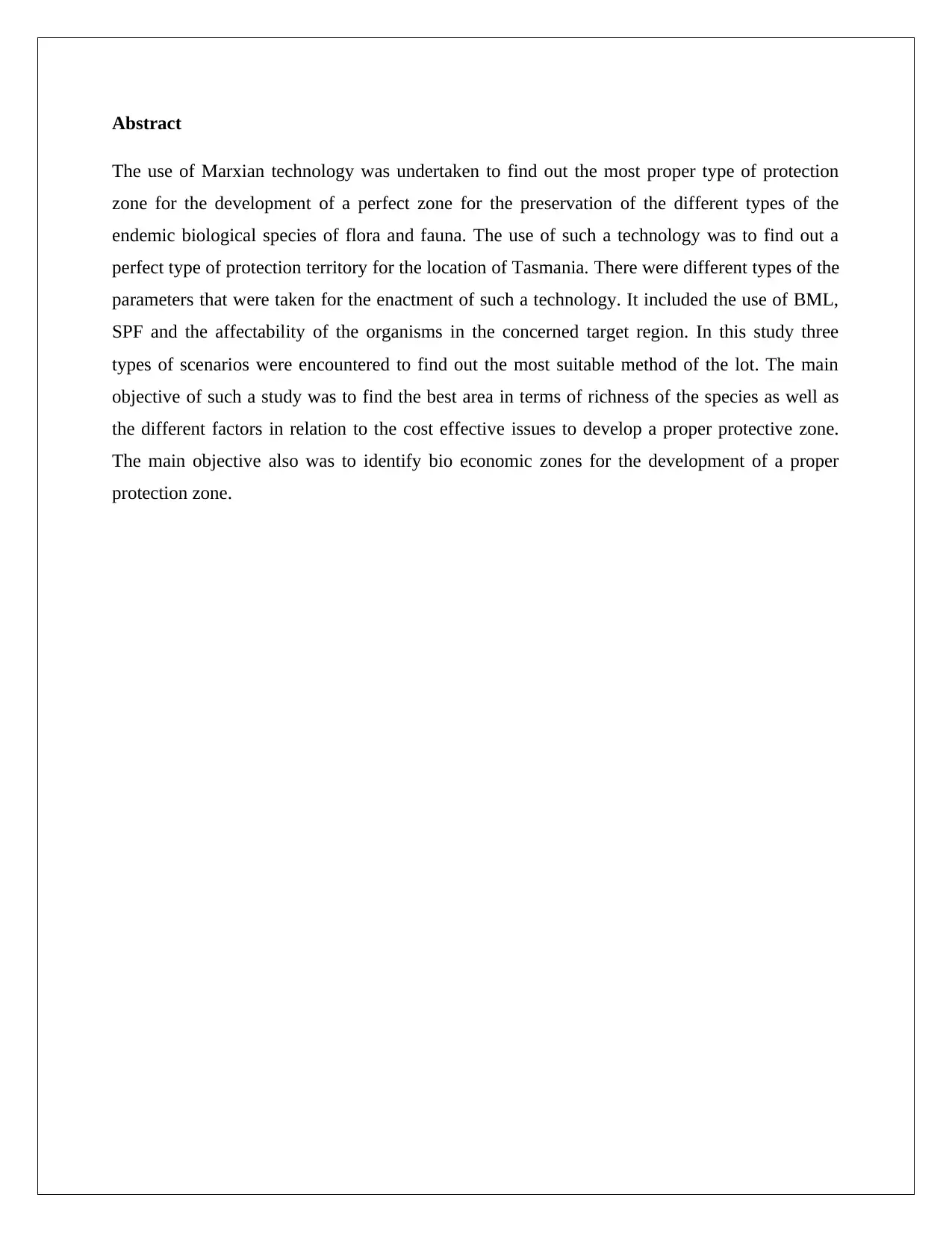
Abstract
The use of Marxian technology was undertaken to find out the most proper type of protection
zone for the development of a perfect zone for the preservation of the different types of the
endemic biological species of flora and fauna. The use of such a technology was to find out a
perfect type of protection territory for the location of Tasmania. There were different types of the
parameters that were taken for the enactment of such a technology. It included the use of BML,
SPF and the affectability of the organisms in the concerned target region. In this study three
types of scenarios were encountered to find out the most suitable method of the lot. The main
objective of such a study was to find the best area in terms of richness of the species as well as
the different factors in relation to the cost effective issues to develop a proper protective zone.
The main objective also was to identify bio economic zones for the development of a proper
protection zone.
The use of Marxian technology was undertaken to find out the most proper type of protection
zone for the development of a perfect zone for the preservation of the different types of the
endemic biological species of flora and fauna. The use of such a technology was to find out a
perfect type of protection territory for the location of Tasmania. There were different types of the
parameters that were taken for the enactment of such a technology. It included the use of BML,
SPF and the affectability of the organisms in the concerned target region. In this study three
types of scenarios were encountered to find out the most suitable method of the lot. The main
objective of such a study was to find the best area in terms of richness of the species as well as
the different factors in relation to the cost effective issues to develop a proper protective zone.
The main objective also was to identify bio economic zones for the development of a proper
protection zone.

Table of Contents
Introduction......................................................................................................................................3
Methods...........................................................................................................................................5
Results..............................................................................................................................................8
Discussions....................................................................................................................................12
References......................................................................................................................................14
Introduction......................................................................................................................................3
Methods...........................................................................................................................................5
Results..............................................................................................................................................8
Discussions....................................................................................................................................12
References......................................................................................................................................14
⊘ This is a preview!⊘
Do you want full access?
Subscribe today to unlock all pages.

Trusted by 1+ million students worldwide
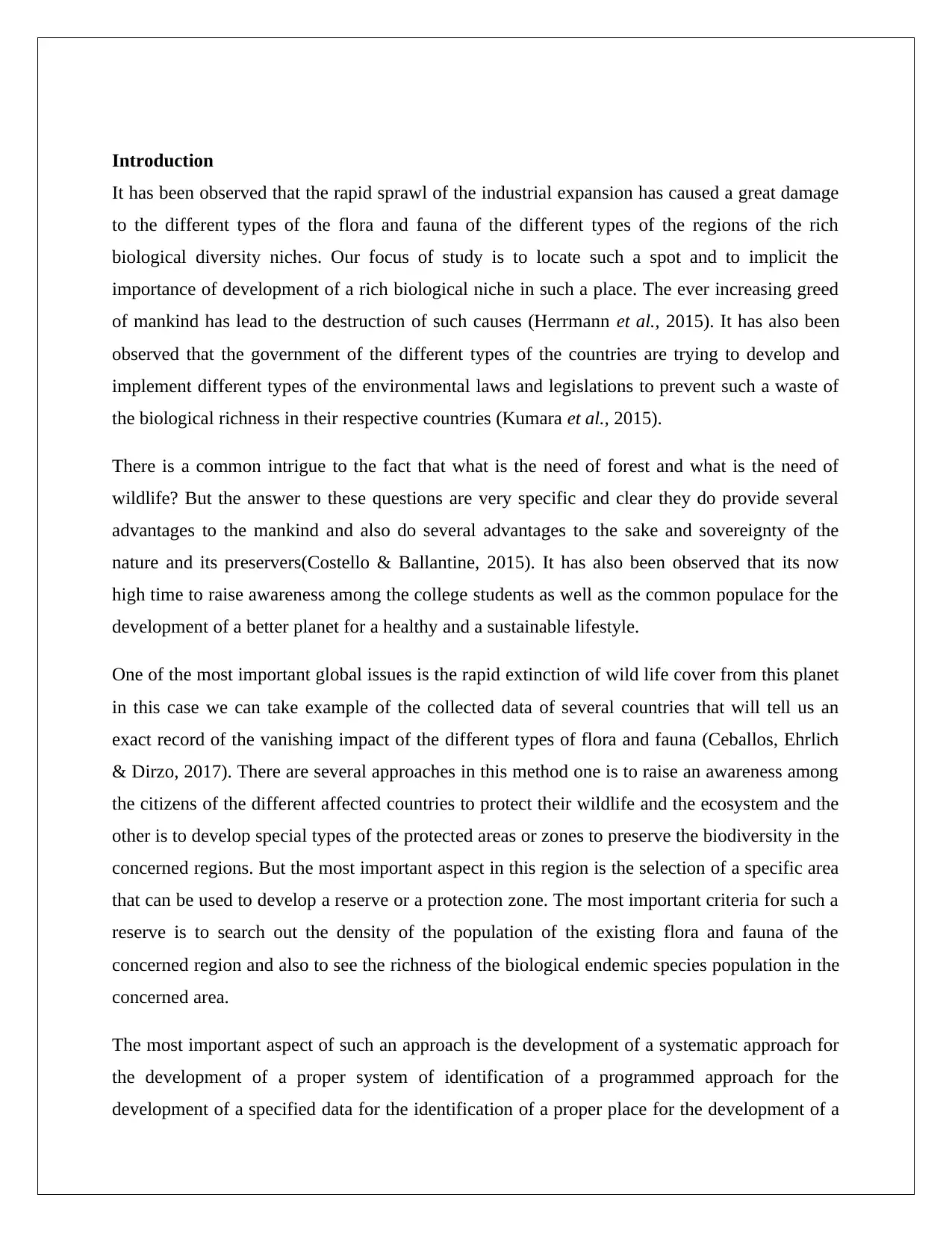
Introduction
It has been observed that the rapid sprawl of the industrial expansion has caused a great damage
to the different types of the flora and fauna of the different types of the regions of the rich
biological diversity niches. Our focus of study is to locate such a spot and to implicit the
importance of development of a rich biological niche in such a place. The ever increasing greed
of mankind has lead to the destruction of such causes (Herrmann et al., 2015). It has also been
observed that the government of the different types of the countries are trying to develop and
implement different types of the environmental laws and legislations to prevent such a waste of
the biological richness in their respective countries (Kumara et al., 2015).
There is a common intrigue to the fact that what is the need of forest and what is the need of
wildlife? But the answer to these questions are very specific and clear they do provide several
advantages to the mankind and also do several advantages to the sake and sovereignty of the
nature and its preservers(Costello & Ballantine, 2015). It has also been observed that its now
high time to raise awareness among the college students as well as the common populace for the
development of a better planet for a healthy and a sustainable lifestyle.
One of the most important global issues is the rapid extinction of wild life cover from this planet
in this case we can take example of the collected data of several countries that will tell us an
exact record of the vanishing impact of the different types of flora and fauna (Ceballos, Ehrlich
& Dirzo, 2017). There are several approaches in this method one is to raise an awareness among
the citizens of the different affected countries to protect their wildlife and the ecosystem and the
other is to develop special types of the protected areas or zones to preserve the biodiversity in the
concerned regions. But the most important aspect in this region is the selection of a specific area
that can be used to develop a reserve or a protection zone. The most important criteria for such a
reserve is to search out the density of the population of the existing flora and fauna of the
concerned region and also to see the richness of the biological endemic species population in the
concerned area.
The most important aspect of such an approach is the development of a systematic approach for
the development of a proper system of identification of a programmed approach for the
development of a specified data for the identification of a proper place for the development of a
It has been observed that the rapid sprawl of the industrial expansion has caused a great damage
to the different types of the flora and fauna of the different types of the regions of the rich
biological diversity niches. Our focus of study is to locate such a spot and to implicit the
importance of development of a rich biological niche in such a place. The ever increasing greed
of mankind has lead to the destruction of such causes (Herrmann et al., 2015). It has also been
observed that the government of the different types of the countries are trying to develop and
implement different types of the environmental laws and legislations to prevent such a waste of
the biological richness in their respective countries (Kumara et al., 2015).
There is a common intrigue to the fact that what is the need of forest and what is the need of
wildlife? But the answer to these questions are very specific and clear they do provide several
advantages to the mankind and also do several advantages to the sake and sovereignty of the
nature and its preservers(Costello & Ballantine, 2015). It has also been observed that its now
high time to raise awareness among the college students as well as the common populace for the
development of a better planet for a healthy and a sustainable lifestyle.
One of the most important global issues is the rapid extinction of wild life cover from this planet
in this case we can take example of the collected data of several countries that will tell us an
exact record of the vanishing impact of the different types of flora and fauna (Ceballos, Ehrlich
& Dirzo, 2017). There are several approaches in this method one is to raise an awareness among
the citizens of the different affected countries to protect their wildlife and the ecosystem and the
other is to develop special types of the protected areas or zones to preserve the biodiversity in the
concerned regions. But the most important aspect in this region is the selection of a specific area
that can be used to develop a reserve or a protection zone. The most important criteria for such a
reserve is to search out the density of the population of the existing flora and fauna of the
concerned region and also to see the richness of the biological endemic species population in the
concerned area.
The most important aspect of such an approach is the development of a systematic approach for
the development of a proper system of identification of a programmed approach for the
development of a specified data for the identification of a proper place for the development of a
Paraphrase This Document
Need a fresh take? Get an instant paraphrase of this document with our AI Paraphraser
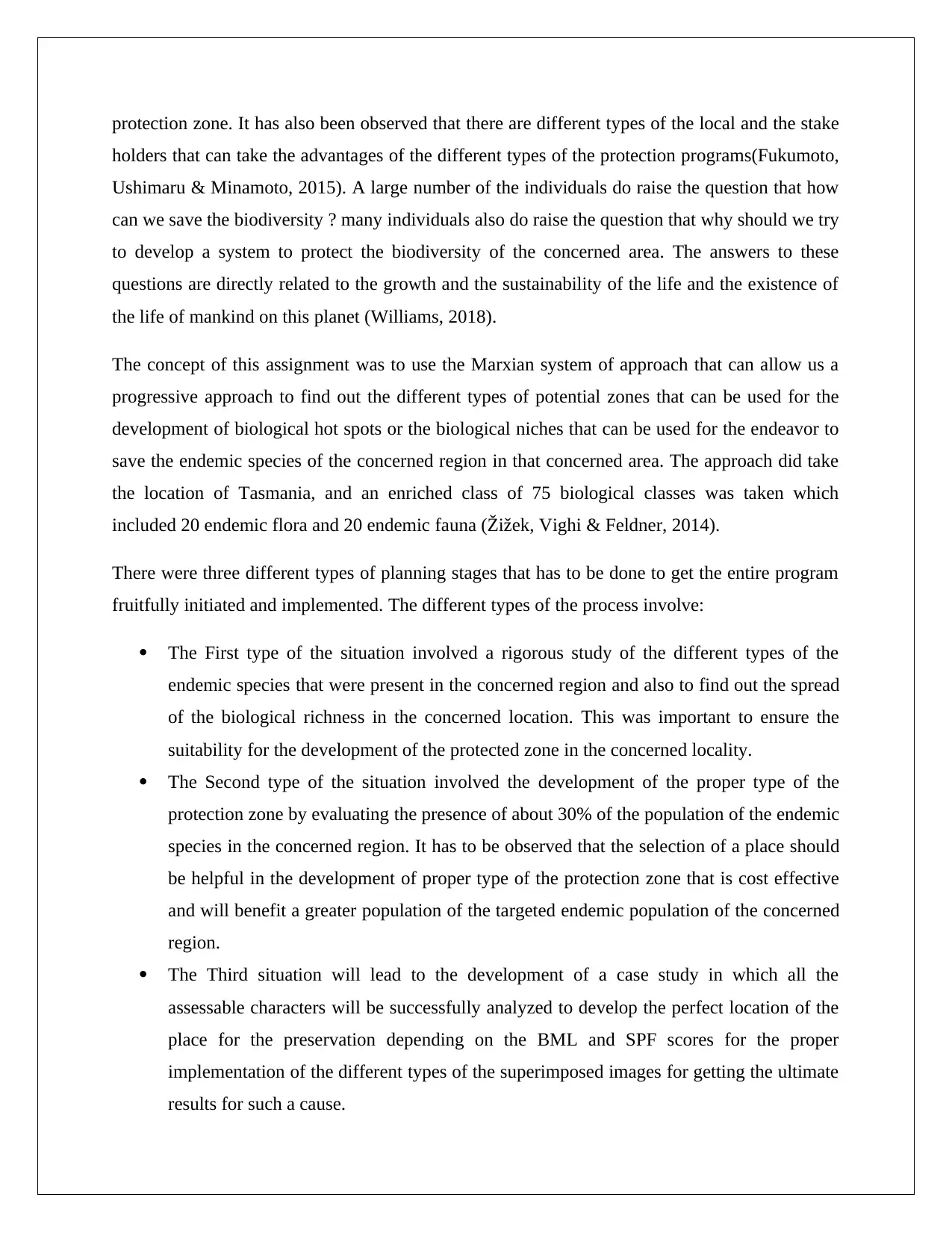
protection zone. It has also been observed that there are different types of the local and the stake
holders that can take the advantages of the different types of the protection programs(Fukumoto,
Ushimaru & Minamoto, 2015). A large number of the individuals do raise the question that how
can we save the biodiversity ? many individuals also do raise the question that why should we try
to develop a system to protect the biodiversity of the concerned area. The answers to these
questions are directly related to the growth and the sustainability of the life and the existence of
the life of mankind on this planet (Williams, 2018).
The concept of this assignment was to use the Marxian system of approach that can allow us a
progressive approach to find out the different types of potential zones that can be used for the
development of biological hot spots or the biological niches that can be used for the endeavor to
save the endemic species of the concerned region in that concerned area. The approach did take
the location of Tasmania, and an enriched class of 75 biological classes was taken which
included 20 endemic flora and 20 endemic fauna (Žižek, Vighi & Feldner, 2014).
There were three different types of planning stages that has to be done to get the entire program
fruitfully initiated and implemented. The different types of the process involve:
The First type of the situation involved a rigorous study of the different types of the
endemic species that were present in the concerned region and also to find out the spread
of the biological richness in the concerned location. This was important to ensure the
suitability for the development of the protected zone in the concerned locality.
The Second type of the situation involved the development of the proper type of the
protection zone by evaluating the presence of about 30% of the population of the endemic
species in the concerned region. It has to be observed that the selection of a place should
be helpful in the development of proper type of the protection zone that is cost effective
and will benefit a greater population of the targeted endemic population of the concerned
region.
The Third situation will lead to the development of a case study in which all the
assessable characters will be successfully analyzed to develop the perfect location of the
place for the preservation depending on the BML and SPF scores for the proper
implementation of the different types of the superimposed images for getting the ultimate
results for such a cause.
holders that can take the advantages of the different types of the protection programs(Fukumoto,
Ushimaru & Minamoto, 2015). A large number of the individuals do raise the question that how
can we save the biodiversity ? many individuals also do raise the question that why should we try
to develop a system to protect the biodiversity of the concerned area. The answers to these
questions are directly related to the growth and the sustainability of the life and the existence of
the life of mankind on this planet (Williams, 2018).
The concept of this assignment was to use the Marxian system of approach that can allow us a
progressive approach to find out the different types of potential zones that can be used for the
development of biological hot spots or the biological niches that can be used for the endeavor to
save the endemic species of the concerned region in that concerned area. The approach did take
the location of Tasmania, and an enriched class of 75 biological classes was taken which
included 20 endemic flora and 20 endemic fauna (Žižek, Vighi & Feldner, 2014).
There were three different types of planning stages that has to be done to get the entire program
fruitfully initiated and implemented. The different types of the process involve:
The First type of the situation involved a rigorous study of the different types of the
endemic species that were present in the concerned region and also to find out the spread
of the biological richness in the concerned location. This was important to ensure the
suitability for the development of the protected zone in the concerned locality.
The Second type of the situation involved the development of the proper type of the
protection zone by evaluating the presence of about 30% of the population of the endemic
species in the concerned region. It has to be observed that the selection of a place should
be helpful in the development of proper type of the protection zone that is cost effective
and will benefit a greater population of the targeted endemic population of the concerned
region.
The Third situation will lead to the development of a case study in which all the
assessable characters will be successfully analyzed to develop the perfect location of the
place for the preservation depending on the BML and SPF scores for the proper
implementation of the different types of the superimposed images for getting the ultimate
results for such a cause.
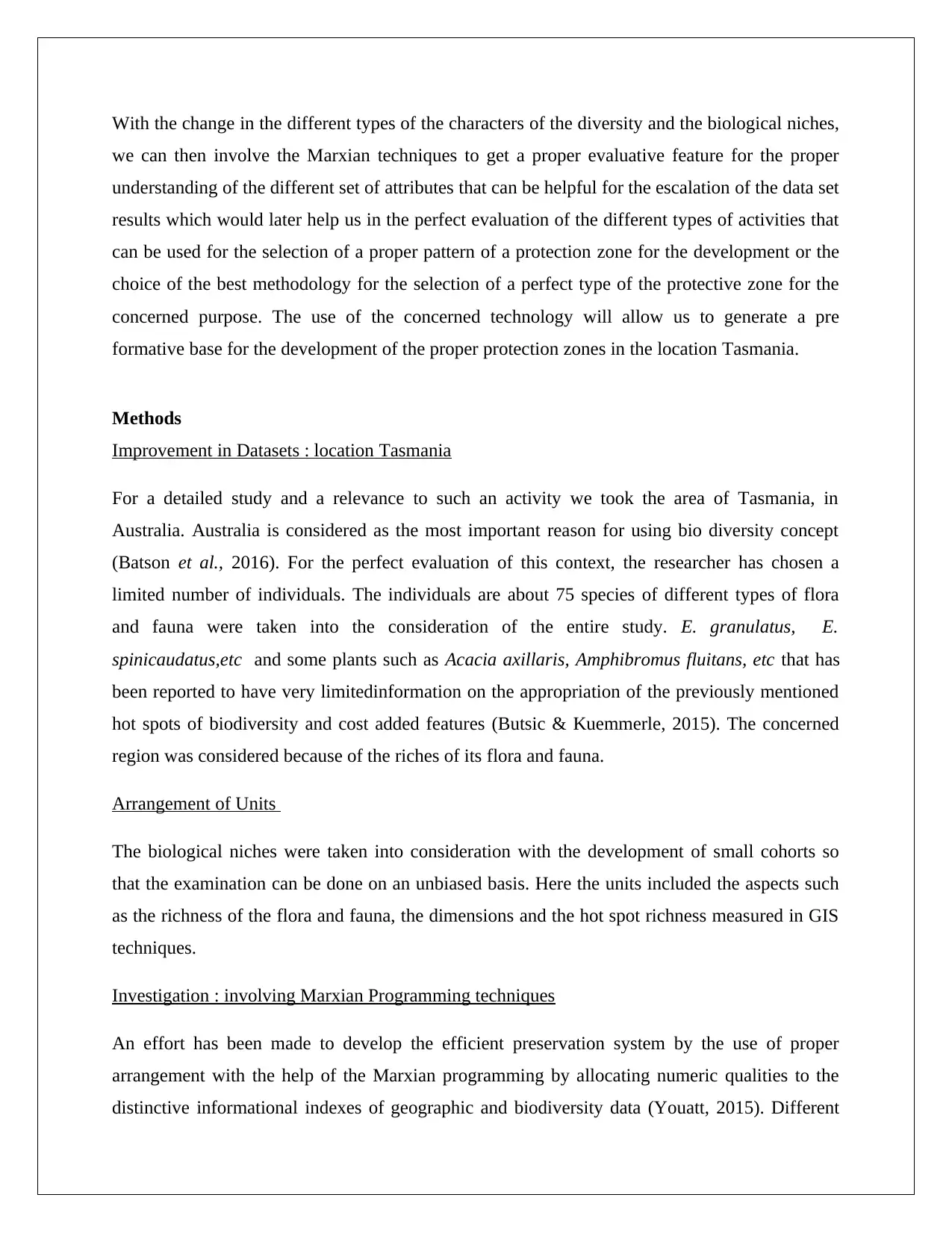
With the change in the different types of the characters of the diversity and the biological niches,
we can then involve the Marxian techniques to get a proper evaluative feature for the proper
understanding of the different set of attributes that can be helpful for the escalation of the data set
results which would later help us in the perfect evaluation of the different types of activities that
can be used for the selection of a proper pattern of a protection zone for the development or the
choice of the best methodology for the selection of a perfect type of the protective zone for the
concerned purpose. The use of the concerned technology will allow us to generate a pre
formative base for the development of the proper protection zones in the location Tasmania.
Methods
Improvement in Datasets : location Tasmania
For a detailed study and a relevance to such an activity we took the area of Tasmania, in
Australia. Australia is considered as the most important reason for using bio diversity concept
(Batson et al., 2016). For the perfect evaluation of this context, the researcher has chosen a
limited number of individuals. The individuals are about 75 species of different types of flora
and fauna were taken into the consideration of the entire study. E. granulatus, E.
spinicaudatus,etc and some plants such as Acacia axillaris, Amphibromus fluitans, etc that has
been reported to have very limitedinformation on the appropriation of the previously mentioned
hot spots of biodiversity and cost added features (Butsic & Kuemmerle, 2015). The concerned
region was considered because of the riches of its flora and fauna.
Arrangement of Units
The biological niches were taken into consideration with the development of small cohorts so
that the examination can be done on an unbiased basis. Here the units included the aspects such
as the richness of the flora and fauna, the dimensions and the hot spot richness measured in GIS
techniques.
Investigation : involving Marxian Programming techniques
An effort has been made to develop the efficient preservation system by the use of proper
arrangement with the help of the Marxian programming by allocating numeric qualities to the
distinctive informational indexes of geographic and biodiversity data (Youatt, 2015). Different
we can then involve the Marxian techniques to get a proper evaluative feature for the proper
understanding of the different set of attributes that can be helpful for the escalation of the data set
results which would later help us in the perfect evaluation of the different types of activities that
can be used for the selection of a proper pattern of a protection zone for the development or the
choice of the best methodology for the selection of a perfect type of the protective zone for the
concerned purpose. The use of the concerned technology will allow us to generate a pre
formative base for the development of the proper protection zones in the location Tasmania.
Methods
Improvement in Datasets : location Tasmania
For a detailed study and a relevance to such an activity we took the area of Tasmania, in
Australia. Australia is considered as the most important reason for using bio diversity concept
(Batson et al., 2016). For the perfect evaluation of this context, the researcher has chosen a
limited number of individuals. The individuals are about 75 species of different types of flora
and fauna were taken into the consideration of the entire study. E. granulatus, E.
spinicaudatus,etc and some plants such as Acacia axillaris, Amphibromus fluitans, etc that has
been reported to have very limitedinformation on the appropriation of the previously mentioned
hot spots of biodiversity and cost added features (Butsic & Kuemmerle, 2015). The concerned
region was considered because of the riches of its flora and fauna.
Arrangement of Units
The biological niches were taken into consideration with the development of small cohorts so
that the examination can be done on an unbiased basis. Here the units included the aspects such
as the richness of the flora and fauna, the dimensions and the hot spot richness measured in GIS
techniques.
Investigation : involving Marxian Programming techniques
An effort has been made to develop the efficient preservation system by the use of proper
arrangement with the help of the Marxian programming by allocating numeric qualities to the
distinctive informational indexes of geographic and biodiversity data (Youatt, 2015). Different
⊘ This is a preview!⊘
Do you want full access?
Subscribe today to unlock all pages.

Trusted by 1+ million students worldwide
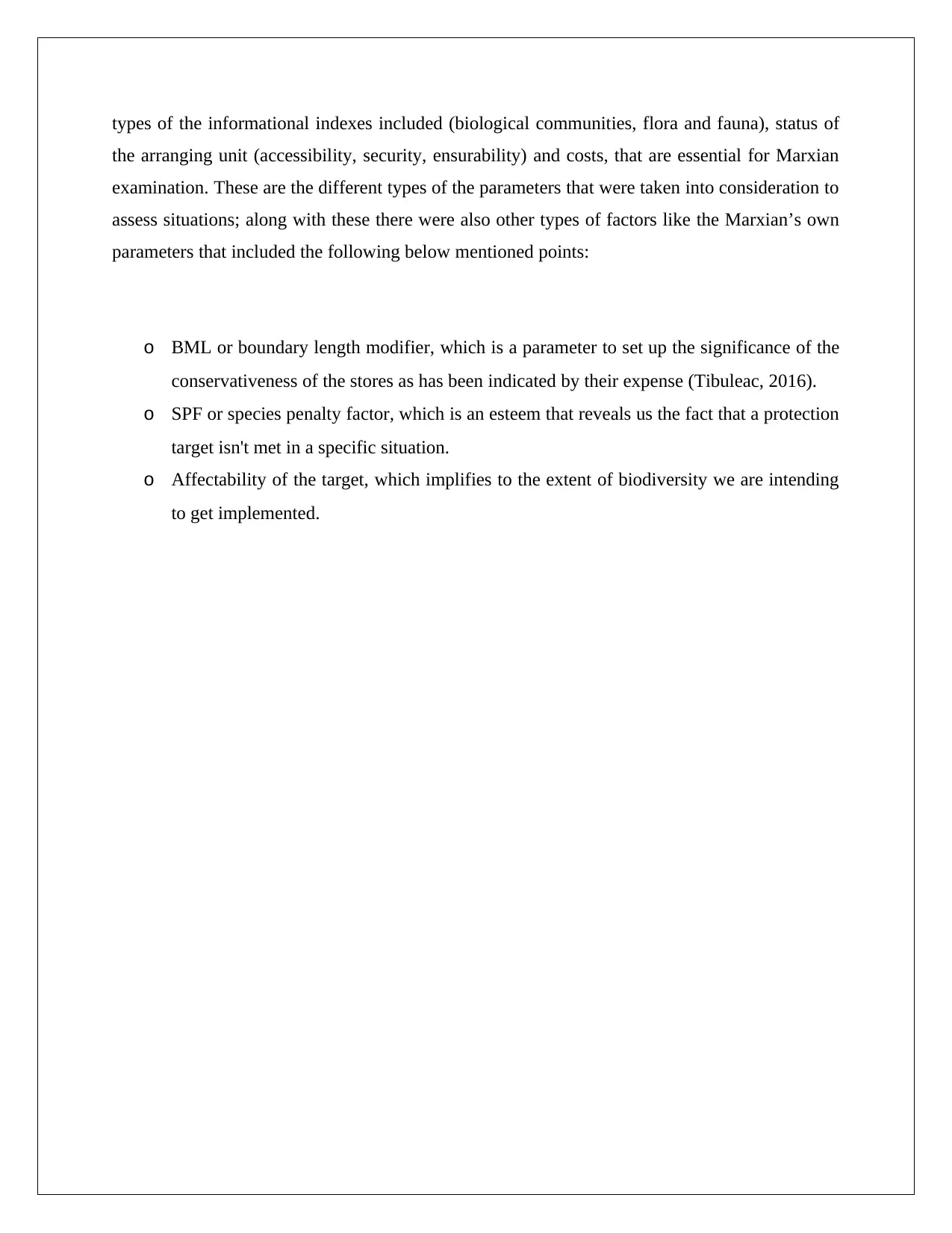
types of the informational indexes included (biological communities, flora and fauna), status of
the arranging unit (accessibility, security, ensurability) and costs, that are essential for Marxian
examination. These are the different types of the parameters that were taken into consideration to
assess situations; along with these there were also other types of factors like the Marxian’s own
parameters that included the following below mentioned points:
o BML or boundary length modifier, which is a parameter to set up the significance of the
conservativeness of the stores as has been indicated by their expense (Tibuleac, 2016).
o SPF or species penalty factor, which is an esteem that reveals us the fact that a protection
target isn't met in a specific situation.
o Affectability of the target, which implifies to the extent of biodiversity we are intending
to get implemented.
the arranging unit (accessibility, security, ensurability) and costs, that are essential for Marxian
examination. These are the different types of the parameters that were taken into consideration to
assess situations; along with these there were also other types of factors like the Marxian’s own
parameters that included the following below mentioned points:
o BML or boundary length modifier, which is a parameter to set up the significance of the
conservativeness of the stores as has been indicated by their expense (Tibuleac, 2016).
o SPF or species penalty factor, which is an esteem that reveals us the fact that a protection
target isn't met in a specific situation.
o Affectability of the target, which implifies to the extent of biodiversity we are intending
to get implemented.
Paraphrase This Document
Need a fresh take? Get an instant paraphrase of this document with our AI Paraphraser
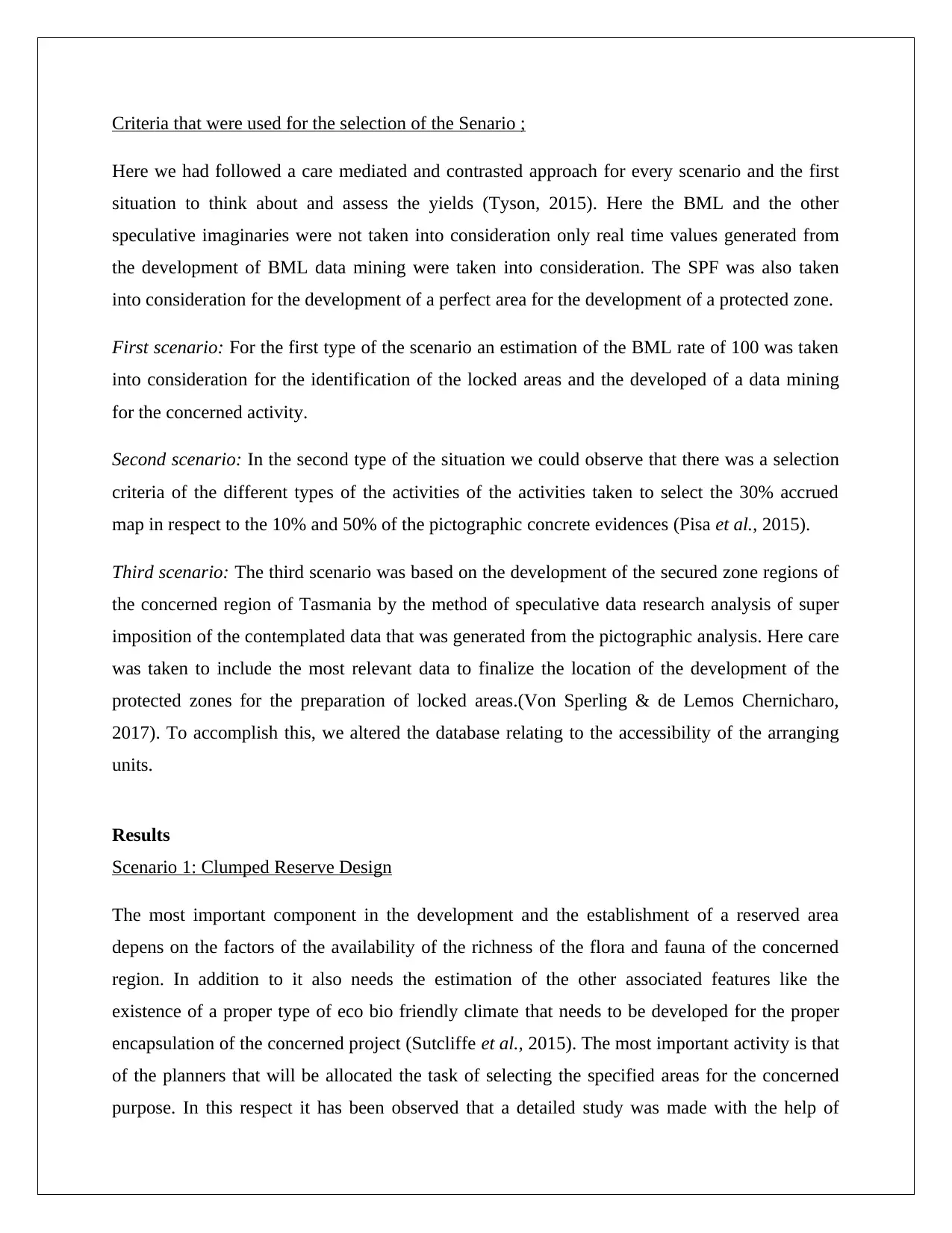
Criteria that were used for the selection of the Senario ;
Here we had followed a care mediated and contrasted approach for every scenario and the first
situation to think about and assess the yields (Tyson, 2015). Here the BML and the other
speculative imaginaries were not taken into consideration only real time values generated from
the development of BML data mining were taken into consideration. The SPF was also taken
into consideration for the development of a perfect area for the development of a protected zone.
First scenario: For the first type of the scenario an estimation of the BML rate of 100 was taken
into consideration for the identification of the locked areas and the developed of a data mining
for the concerned activity.
Second scenario: In the second type of the situation we could observe that there was a selection
criteria of the different types of the activities of the activities taken to select the 30% accrued
map in respect to the 10% and 50% of the pictographic concrete evidences (Pisa et al., 2015).
Third scenario: The third scenario was based on the development of the secured zone regions of
the concerned region of Tasmania by the method of speculative data research analysis of super
imposition of the contemplated data that was generated from the pictographic analysis. Here care
was taken to include the most relevant data to finalize the location of the development of the
protected zones for the preparation of locked areas.(Von Sperling & de Lemos Chernicharo,
2017). To accomplish this, we altered the database relating to the accessibility of the arranging
units.
Results
Scenario 1: Clumped Reserve Design
The most important component in the development and the establishment of a reserved area
depens on the factors of the availability of the richness of the flora and fauna of the concerned
region. In addition to it also needs the estimation of the other associated features like the
existence of a proper type of eco bio friendly climate that needs to be developed for the proper
encapsulation of the concerned project (Sutcliffe et al., 2015). The most important activity is that
of the planners that will be allocated the task of selecting the specified areas for the concerned
purpose. In this respect it has been observed that a detailed study was made with the help of
Here we had followed a care mediated and contrasted approach for every scenario and the first
situation to think about and assess the yields (Tyson, 2015). Here the BML and the other
speculative imaginaries were not taken into consideration only real time values generated from
the development of BML data mining were taken into consideration. The SPF was also taken
into consideration for the development of a perfect area for the development of a protected zone.
First scenario: For the first type of the scenario an estimation of the BML rate of 100 was taken
into consideration for the identification of the locked areas and the developed of a data mining
for the concerned activity.
Second scenario: In the second type of the situation we could observe that there was a selection
criteria of the different types of the activities of the activities taken to select the 30% accrued
map in respect to the 10% and 50% of the pictographic concrete evidences (Pisa et al., 2015).
Third scenario: The third scenario was based on the development of the secured zone regions of
the concerned region of Tasmania by the method of speculative data research analysis of super
imposition of the contemplated data that was generated from the pictographic analysis. Here care
was taken to include the most relevant data to finalize the location of the development of the
protected zones for the preparation of locked areas.(Von Sperling & de Lemos Chernicharo,
2017). To accomplish this, we altered the database relating to the accessibility of the arranging
units.
Results
Scenario 1: Clumped Reserve Design
The most important component in the development and the establishment of a reserved area
depens on the factors of the availability of the richness of the flora and fauna of the concerned
region. In addition to it also needs the estimation of the other associated features like the
existence of a proper type of eco bio friendly climate that needs to be developed for the proper
encapsulation of the concerned project (Sutcliffe et al., 2015). The most important activity is that
of the planners that will be allocated the task of selecting the specified areas for the concerned
purpose. In this respect it has been observed that a detailed study was made with the help of
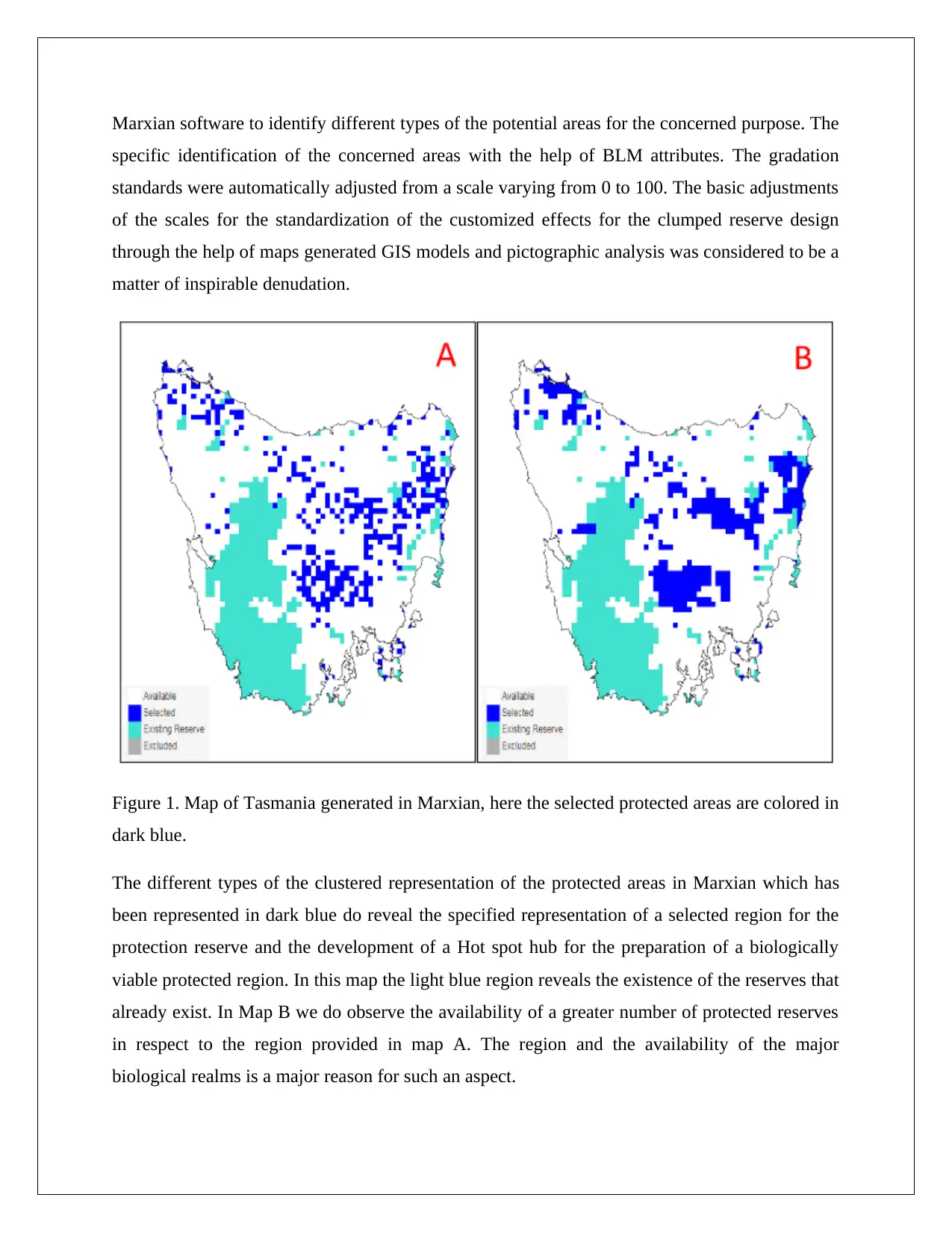
Marxian software to identify different types of the potential areas for the concerned purpose. The
specific identification of the concerned areas with the help of BLM attributes. The gradation
standards were automatically adjusted from a scale varying from 0 to 100. The basic adjustments
of the scales for the standardization of the customized effects for the clumped reserve design
through the help of maps generated GIS models and pictographic analysis was considered to be a
matter of inspirable denudation.
Figure 1. Map of Tasmania generated in Marxian, here the selected protected areas are colored in
dark blue.
The different types of the clustered representation of the protected areas in Marxian which has
been represented in dark blue do reveal the specified representation of a selected region for the
protection reserve and the development of a Hot spot hub for the preparation of a biologically
viable protected region. In this map the light blue region reveals the existence of the reserves that
already exist. In Map B we do observe the availability of a greater number of protected reserves
in respect to the region provided in map A. The region and the availability of the major
biological realms is a major reason for such an aspect.
specific identification of the concerned areas with the help of BLM attributes. The gradation
standards were automatically adjusted from a scale varying from 0 to 100. The basic adjustments
of the scales for the standardization of the customized effects for the clumped reserve design
through the help of maps generated GIS models and pictographic analysis was considered to be a
matter of inspirable denudation.
Figure 1. Map of Tasmania generated in Marxian, here the selected protected areas are colored in
dark blue.
The different types of the clustered representation of the protected areas in Marxian which has
been represented in dark blue do reveal the specified representation of a selected region for the
protection reserve and the development of a Hot spot hub for the preparation of a biologically
viable protected region. In this map the light blue region reveals the existence of the reserves that
already exist. In Map B we do observe the availability of a greater number of protected reserves
in respect to the region provided in map A. The region and the availability of the major
biological realms is a major reason for such an aspect.
⊘ This is a preview!⊘
Do you want full access?
Subscribe today to unlock all pages.

Trusted by 1+ million students worldwide
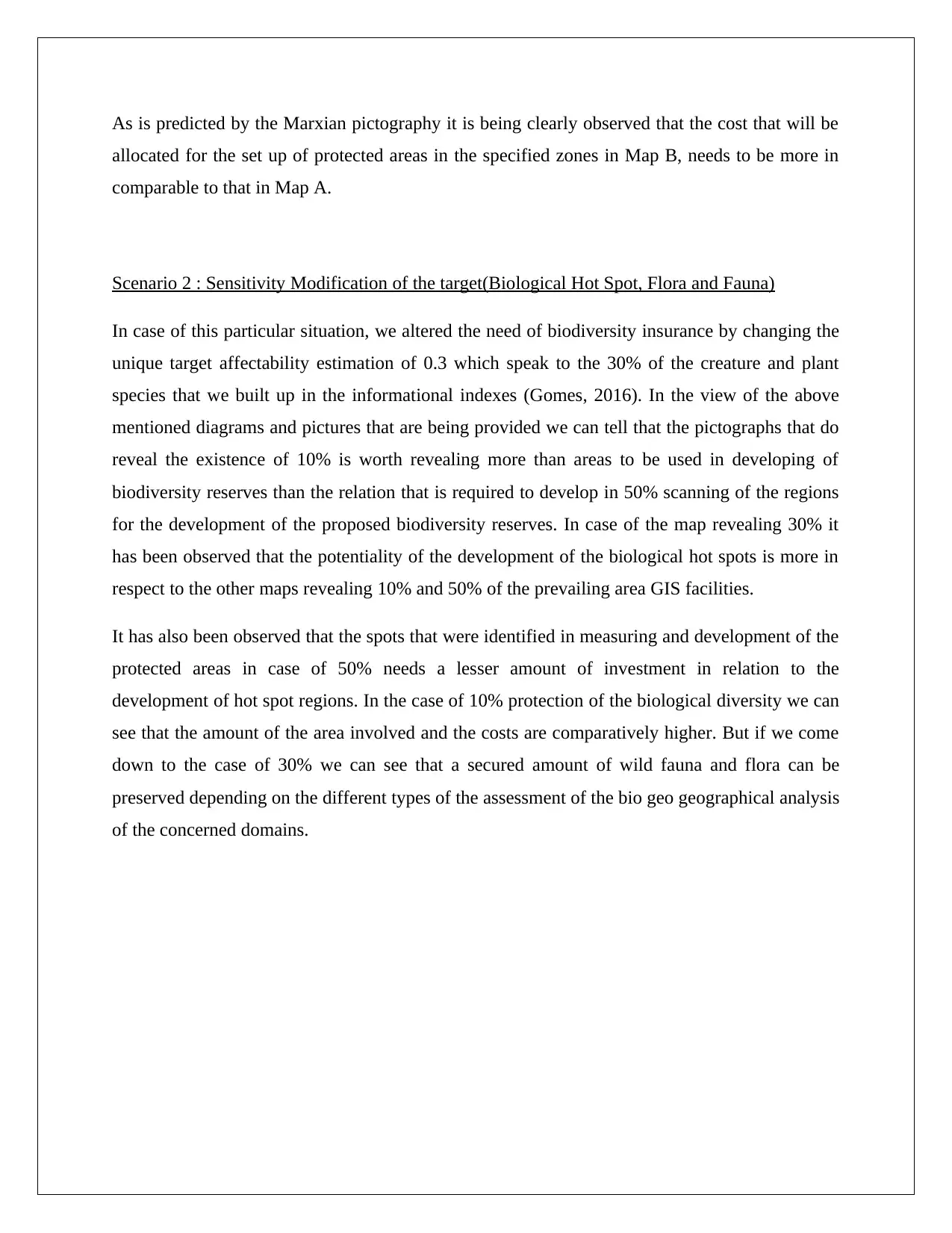
As is predicted by the Marxian pictography it is being clearly observed that the cost that will be
allocated for the set up of protected areas in the specified zones in Map B, needs to be more in
comparable to that in Map A.
Scenario 2 : Sensitivity Modification of the target(Biological Hot Spot, Flora and Fauna)
In case of this particular situation, we altered the need of biodiversity insurance by changing the
unique target affectability estimation of 0.3 which speak to the 30% of the creature and plant
species that we built up in the informational indexes (Gomes, 2016). In the view of the above
mentioned diagrams and pictures that are being provided we can tell that the pictographs that do
reveal the existence of 10% is worth revealing more than areas to be used in developing of
biodiversity reserves than the relation that is required to develop in 50% scanning of the regions
for the development of the proposed biodiversity reserves. In case of the map revealing 30% it
has been observed that the potentiality of the development of the biological hot spots is more in
respect to the other maps revealing 10% and 50% of the prevailing area GIS facilities.
It has also been observed that the spots that were identified in measuring and development of the
protected areas in case of 50% needs a lesser amount of investment in relation to the
development of hot spot regions. In the case of 10% protection of the biological diversity we can
see that the amount of the area involved and the costs are comparatively higher. But if we come
down to the case of 30% we can see that a secured amount of wild fauna and flora can be
preserved depending on the different types of the assessment of the bio geo geographical analysis
of the concerned domains.
allocated for the set up of protected areas in the specified zones in Map B, needs to be more in
comparable to that in Map A.
Scenario 2 : Sensitivity Modification of the target(Biological Hot Spot, Flora and Fauna)
In case of this particular situation, we altered the need of biodiversity insurance by changing the
unique target affectability estimation of 0.3 which speak to the 30% of the creature and plant
species that we built up in the informational indexes (Gomes, 2016). In the view of the above
mentioned diagrams and pictures that are being provided we can tell that the pictographs that do
reveal the existence of 10% is worth revealing more than areas to be used in developing of
biodiversity reserves than the relation that is required to develop in 50% scanning of the regions
for the development of the proposed biodiversity reserves. In case of the map revealing 30% it
has been observed that the potentiality of the development of the biological hot spots is more in
respect to the other maps revealing 10% and 50% of the prevailing area GIS facilities.
It has also been observed that the spots that were identified in measuring and development of the
protected areas in case of 50% needs a lesser amount of investment in relation to the
development of hot spot regions. In the case of 10% protection of the biological diversity we can
see that the amount of the area involved and the costs are comparatively higher. But if we come
down to the case of 30% we can see that a secured amount of wild fauna and flora can be
preserved depending on the different types of the assessment of the bio geo geographical analysis
of the concerned domains.
Paraphrase This Document
Need a fresh take? Get an instant paraphrase of this document with our AI Paraphraser
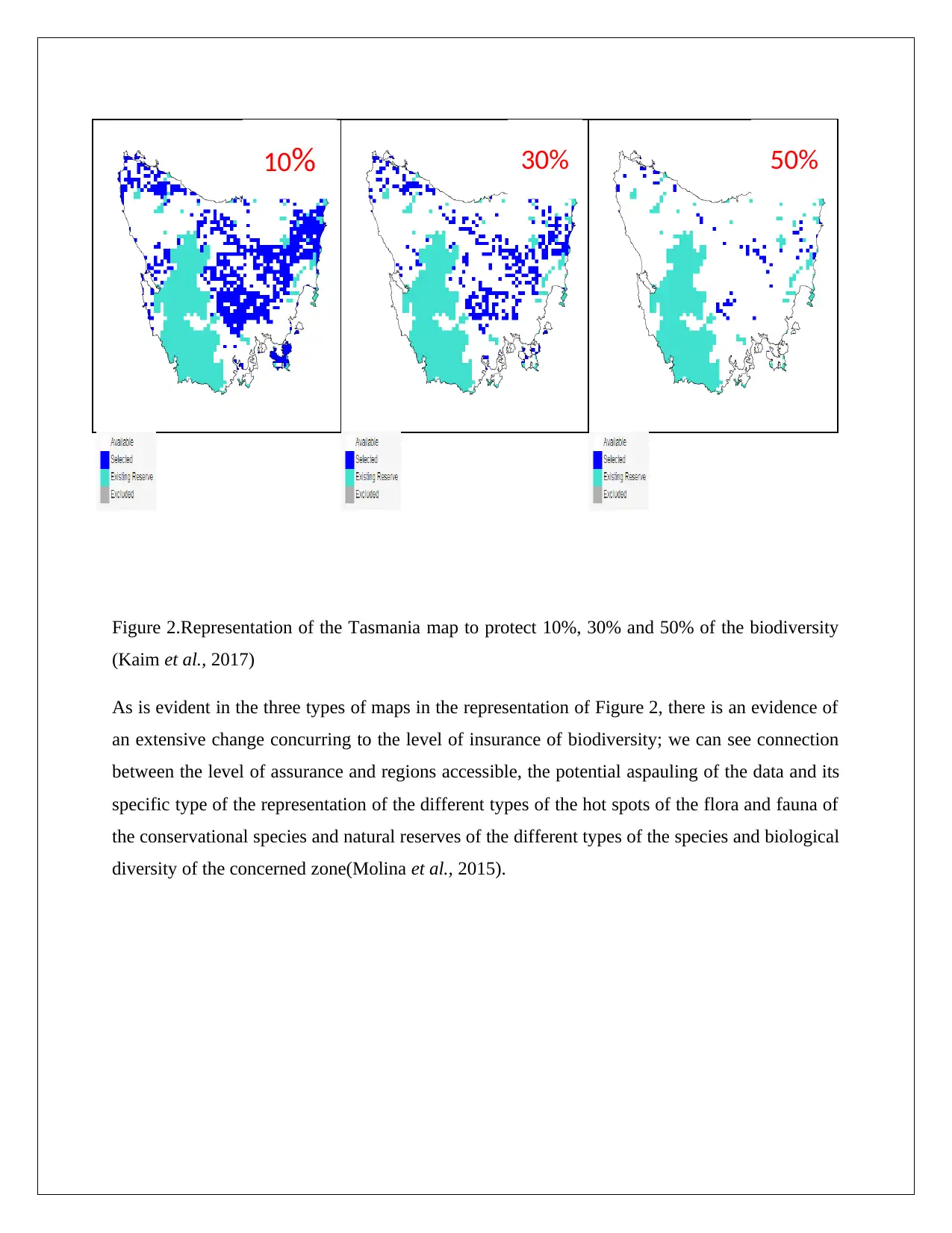
Figure 2.Representation of the Tasmania map to protect 10%, 30% and 50% of the biodiversity
(Kaim et al., 2017)
As is evident in the three types of maps in the representation of Figure 2, there is an evidence of
an extensive change concurring to the level of insurance of biodiversity; we can see connection
between the level of assurance and regions accessible, the potential aspauling of the data and its
specific type of the representation of the different types of the hot spots of the flora and fauna of
the conservational species and natural reserves of the different types of the species and biological
diversity of the concerned zone(Molina et al., 2015).
10% 30% 50%
(Kaim et al., 2017)
As is evident in the three types of maps in the representation of Figure 2, there is an evidence of
an extensive change concurring to the level of insurance of biodiversity; we can see connection
between the level of assurance and regions accessible, the potential aspauling of the data and its
specific type of the representation of the different types of the hot spots of the flora and fauna of
the conservational species and natural reserves of the different types of the species and biological
diversity of the concerned zone(Molina et al., 2015).
10% 30% 50%
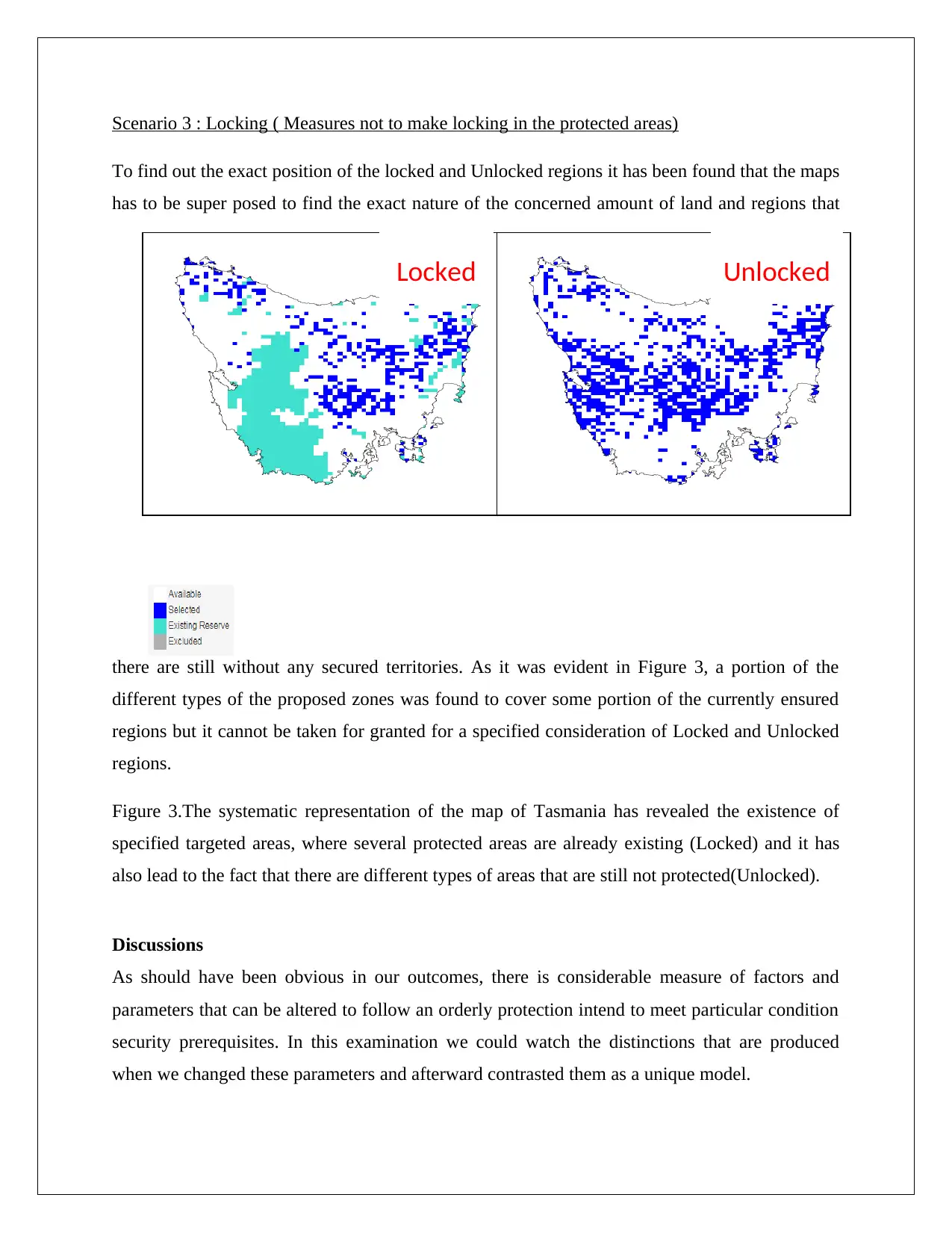
Scenario 3 : Locking ( Measures not to make locking in the protected areas)
To find out the exact position of the locked and Unlocked regions it has been found that the maps
has to be super posed to find the exact nature of the concerned amount of land and regions that
there are still without any secured territories. As it was evident in Figure 3, a portion of the
different types of the proposed zones was found to cover some portion of the currently ensured
regions but it cannot be taken for granted for a specified consideration of Locked and Unlocked
regions.
Figure 3.The systematic representation of the map of Tasmania has revealed the existence of
specified targeted areas, where several protected areas are already existing (Locked) and it has
also lead to the fact that there are different types of areas that are still not protected(Unlocked).
Discussions
As should have been obvious in our outcomes, there is considerable measure of factors and
parameters that can be altered to follow an orderly protection intend to meet particular condition
security prerequisites. In this examination we could watch the distinctions that are produced
when we changed these parameters and afterward contrasted them as a unique model.
Locked Unlocked
To find out the exact position of the locked and Unlocked regions it has been found that the maps
has to be super posed to find the exact nature of the concerned amount of land and regions that
there are still without any secured territories. As it was evident in Figure 3, a portion of the
different types of the proposed zones was found to cover some portion of the currently ensured
regions but it cannot be taken for granted for a specified consideration of Locked and Unlocked
regions.
Figure 3.The systematic representation of the map of Tasmania has revealed the existence of
specified targeted areas, where several protected areas are already existing (Locked) and it has
also lead to the fact that there are different types of areas that are still not protected(Unlocked).
Discussions
As should have been obvious in our outcomes, there is considerable measure of factors and
parameters that can be altered to follow an orderly protection intend to meet particular condition
security prerequisites. In this examination we could watch the distinctions that are produced
when we changed these parameters and afterward contrasted them as a unique model.
Locked Unlocked
⊘ This is a preview!⊘
Do you want full access?
Subscribe today to unlock all pages.

Trusted by 1+ million students worldwide
1 out of 16
Your All-in-One AI-Powered Toolkit for Academic Success.
+13062052269
info@desklib.com
Available 24*7 on WhatsApp / Email
![[object Object]](/_next/static/media/star-bottom.7253800d.svg)
Unlock your academic potential
Copyright © 2020–2025 A2Z Services. All Rights Reserved. Developed and managed by ZUCOL.